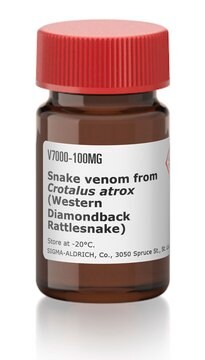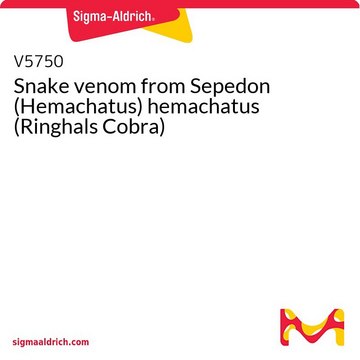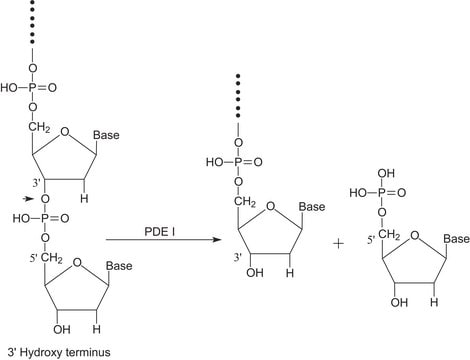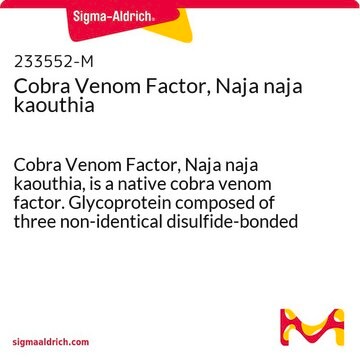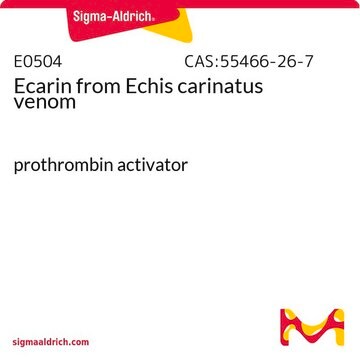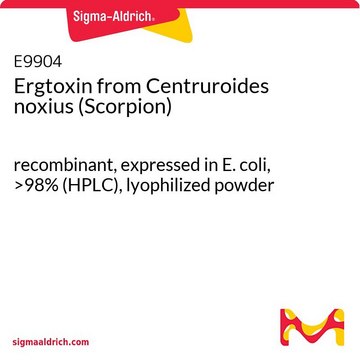V5625
Snake venom from Bothrops jararaca
Synonyme(s) :
South American Pit Viper
Se connecterpour consulter vos tarifs contractuels et ceux de votre entreprise/organisme
About This Item
Code UNSPSC :
12352202
Nomenclature NACRES :
NA.77
Produits recommandés
Actions biochimiques/physiologiques
Snake venom from Bothrops jararaca mainly contains three types of toxins snake venom metalloproteinases (SVMP), snake venom serine proteases (SVSP), and C-type lectin-like proteins (CTLP). These toxins aids in the pathogenesis of envenomation by activating blood coagulation prothrombin, von Willebrand factor (VWF), and factor X, and by altering the function of protein C, kininogen, and blood platelets.
Code de la classe de stockage
11 - Combustible Solids
Classe de danger pour l'eau (WGK)
WGK 3
Point d'éclair (°F)
Not applicable
Point d'éclair (°C)
Not applicable
Équipement de protection individuelle
Eyeshields, Gloves, type N95 (US)
Faites votre choix parmi les versions les plus récentes :
Déjà en possession de ce produit ?
Retrouvez la documentation relative aux produits que vous avez récemment achetés dans la Bibliothèque de documents.
Aqueous leaf extract of Jatropha mollissima (Pohl) Bail decreases local effects induced by bothropic venom
Gomes Jacyra Antunes dos S, et al.
BioMed Research International, 2016, e0160638-e0160638 (2016)
Glutamate receptor interacting protein 1 mediates platelet adhesion and thrombus formation
Modjeski KL, et al.
PLoS ONE, 11(9), e0160638-e0160638 (2016)
K M Brinkhous et al.
Proceedings of the National Academy of Sciences of the United States of America, 80(5), 1463-1466 (1983-03-01)
Botrocetin, originally called venom coagglutinin, is a Bothrops factor that causes aggregation of blood platelets in the presence of the von Willebrand component of the factor VIII macromolecular complex. The complex consists of a series of multimers with a molecular
Inhibitory Effects of Hydroethanolic Leaf Extracts of Kalanchoe brasiliensis and Kalanchoe pinnata (Crassulaceae) against Local Effects Induced by Bothrops jararaca Snake Venom
Fernandes JM, et al.
PLoS ONE, 11(12), e0168658-e0168658 (2016)
Júlia Morais Fernandes et al.
PloS one, 11(12), e0168658-e0168658 (2016-12-30)
The species Kalanchoe brasiliensis and Kalanchoe pinnata, both known popularly as "Saião," are used interchangeably in traditional medicine for their antiophidic properties. Studies evaluating the anti-venom activity of these species are scarce. This study aims to characterize the chemical constituents
Notre équipe de scientifiques dispose d'une expérience dans tous les secteurs de la recherche, notamment en sciences de la vie, science des matériaux, synthèse chimique, chromatographie, analyse et dans de nombreux autres domaines..
Contacter notre Service technique